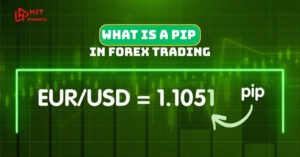Are you exploring what is a direct quotation and its significance in Forex trading? This is a fundamental yet incredibly important concept that helps you accurately interpret exchange rates, especially when you're new to the market. This article will thoroughly explain direct quotation, how it's presented, and why mastering this concept is essential. Let's dive into the details with H2T Finance!
1. What is a direct quotation?
In the world of Forex, a direct quotation, often referred to as a direct currency quotation, is a straightforward way of expressing the value of a foreign currency.
The core of the direct quote definition lies in how it presents this value: it shows how many units of your domestic currency are needed to purchase one single unit of a foreign currency. This method provides a clear and immediate understanding of a foreign currency's cost in terms of your home currency.
For our readers in the United States, this concept is particularly easy to grasp. When you see a direct quotation, your domestic currency, the U.S. dollar (USD), is used as the reference to price the foreign currency. So, the quote will tell you exactly how many U.S. dollars you would need to exchange to obtain one unit of, for example, the euro (EUR) or the British pound (GBP).
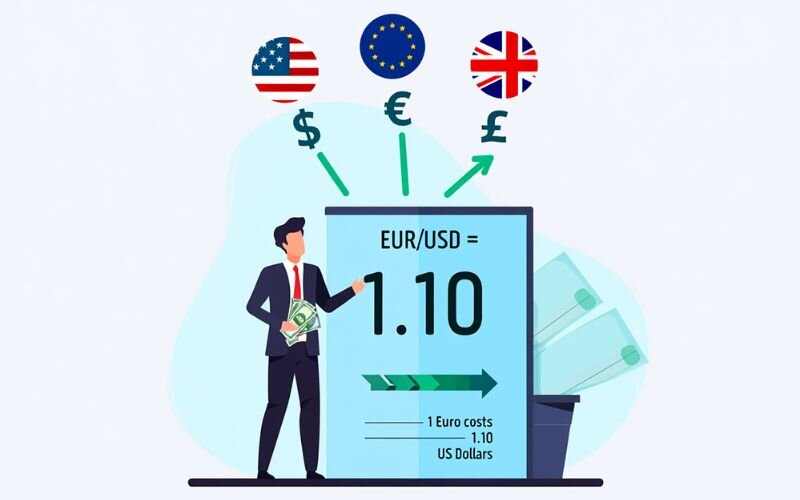
The term "direct" is used because the quotation directly answers the question: "How much of my money does it take to buy one unit of their money?" There's no complex calculation needed to understand the foreign currency's price in terms of your local currency. It’s a very transparent way of looking at exchange rates, especially for those new to the Forex market. This contrasts with other ways of quoting currencies, which we will explore later.
2. What is a direct quotation example?
Direct quotations are particularly user-friendly for beginners, as they offer a transparent view of exchange rates. Example:
For a trader in the United States, a direct quotation might look like this:
EUR/USD = 1.10
This means that to buy 1 euro (EUR), you need 1.10 U.S. dollars (USD). In this case, the USD is the domestic currency, and the quote gives a clear understanding of how much you need to spend to obtain euros.
This straightforward approach allows you to quickly assess the value of a foreign currency without any complex calculations. If the quote changes to:
EUR/USD = 1.15
It indicates that the euro has become more expensive, and you now need 1.15 USD to buy 1 euro.
3. How is a direct quotation expressed in Forex?
Understanding how a direct quotation is structured is key to reading and interpreting Forex rates accurately. This involves recognizing the roles of the two currencies involved in any pair.
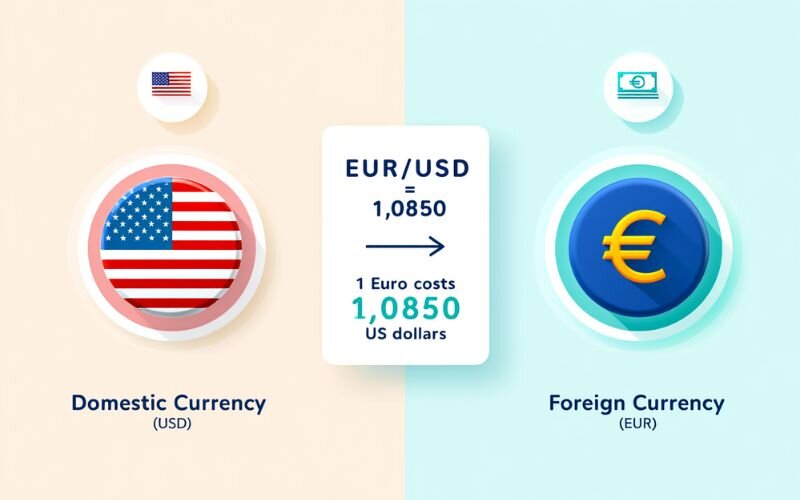
3.1. The fundamental roles of base currency and quote currency
In any currency pair quotation, there are always two currencies: the base currency and the quote currency (also known as the counter currency). How does direct quotation relate to base and quote currency? In a direct quotation, the roles are specifically assigned as follows:
- The foreign currency always acts as the base currency. The base currency is the first currency listed in a pair (e.g., EUR in EUR/USD) and is always equal to one unit.
- Your domestic currency acts as the quote currency (or counter currency). The quote currency is the second currency listed and indicates how much of this domestic currency is needed to buy one unit of the base (foreign) currency.
Let's consider a classic direct quotation forex example for someone in the United States:
EUR/USD = 1.0850
In this example:
- EUR (Euro) is the base currency (the foreign currency).
- USD (U.S. Dollar) is the quote currency (the domestic currency for a U.S. resident).
The quotation means that 1 Euro costs 1.0850 U.S. Dollars. The foreign currency in direct quote (EUR) is what you are "buying," and the domestic currency in direct quote (USD) is what you are "using to pay."
3.2. Reading and interpreting a direct quotation example clearly
Once you understand the roles of the base and quote currencies, reading a direct quote becomes intuitive. The number shown in the quotation is simply the price of one unit of the foreign (base) currency in terms of your domestic (quote) currency. This is fundamental to understanding forex quotes.
Let's look at another direct quotation example:
GBP/USD = 1.2700
Here’s how to read forex quotes like this if you are in the United States:
- GBP (British Pound) is the base currency (foreign currency).
- USD (U.S. Dollar) is the quote currency (your domestic currency).
The rate 1.2700 means that you need 1.2700 U.S. Dollars to purchase 1 British Pound.
To make it even simpler, especially when starting, you can ask yourself: "How much of my money (USD) do I need to buy one unit of the foreign money (GBP)?" The answer is directly provided by the direct quotation. The exchange rate explicitly states the value of the base currency (the foreign currency) priced in terms of the quote currency (your domestic currency). Can you give an example of a direct currency quote? Yes, EUR/USD and GBP/USD, when viewed from the U.S., are perfect examples.
See more useful additional articles:
- Topstep Trades Closed by What Time? Full Trading Hour Guide
- The Difference: What is Ask Price vs Bid Price?
- What is leverage in Forex trading? A simple explanation for beginners
4. Direct quotation vs. indirect quotation
While what is a direct quotation provides one way to view currency values, it's not the only method. Its counterpart, the indirect quotation, presents the exchange rate from a different angle. Understanding both currency quotation methods is vital.
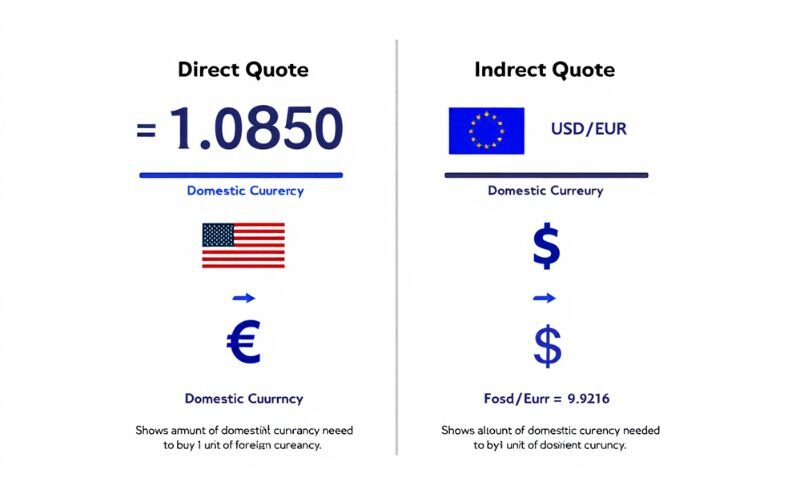
4.1. What is an indirect quotation? A brief overview
An indirect quotation shows how many units of a foreign currency are needed to purchase one single unit of your domestic currency. It essentially flips the perspective compared to a direct quote.
From the viewpoint of someone in the United States (where USD is the domestic currency):
- In an indirect quotation, the U.S. Dollar (USD) serves as the base currency (meaning it's the currency valued at one unit).
- The foreign currency then acts as the quote currency, indicating how much of that foreign currency one USD can buy.
A common example of an indirect quotation for a U.S. resident is:
USD/JPY = 150.00
This means 1 U.S. Dollar (domestic currency, now base currency) can be exchanged for 150.00 Japanese Yen (foreign currency, now quote currency). You are finding out how much foreign currency your one domestic unit is worth.
4.2. Comparing direct vs indirect quotation side-by-side
What is the difference between direct and indirect quotation in Forex? The primary distinction lies in which currency is fixed at one unit (the base currency) and, consequently, what the exchange rate tells you. For a trader in the United States:
| Feature | Direct Quotation (from U.S. Perspective) | Indirect Quotation (from U.S. Perspective) |
| Base Currency | Foreign Currency (e.g., EUR, GBP) | Domestic Currency (USD) |
| Quote Currency | Domestic Currency (USD) | Foreign Currency (e.g., JPY, CAD, CHF) |
| Rate Meaning | How many USD are needed to buy 1 unit of foreign currency? | How many units of foreign currency can be bought with 1 USD? |
| Example | EUR/USD = 1.0850 <br/> (1 EUR costs 1.0850 USD) | USD/CAD = 1.3500 <br/> (1 USD buys 1.3500 CAD) |
This side-by-side comparison clearly illustrates that the "direction" of the quote—whether you're pricing a foreign currency in your domestic terms (direct) or your domestic currency in foreign terms (indirect)—is the key differentiator.
4.3. Why is it important for beginners to distinguish them?
For beginners, clearly distinguishing between direct and indirect quotations is crucial for several practical reasons:
- Avoiding confusion: Misinterpreting a quote can lead to significant errors when analyzing charts, understanding news reports, or placing trades. Knowing whether the rate means "cost of foreign currency" or "value of domestic currency" is fundamental.
- Accurate value assessment: Understanding the quotation type helps you correctly perceive the value of the currency you are trading and the direction of its potential movement. For instance, if EUR/USD (a direct quote for U.S. traders) rises, the Euro is strengthening against the Dollar. If USD/JPY (an indirect quote for U.S. traders) rises, the Dollar is strengthening against the Yen.
- Foundation for calculations: A solid grasp of quotation types is a prerequisite for accurately calculating vital trading parameters like pip value, required margin, and potential profit or loss. These calculations differ slightly depending on how the currency pair is quoted.
Making this distinction early on builds a strong foundation for more advanced Forex concepts.

5. Why is understanding direct quotation crucial for traders?
Grasping what is a direct quotation goes beyond mere definition; it has significant practical implications for anyone involved in Forex trading. This understanding directly impacts how you interact with trading platforms and interpret market information.
Firstly, a clear comprehension of direct (and indirect) quotations is essential for accurately reading and interpreting the exchange rate quotation displayed on popular trading platforms like MetaTrader 4 (MT4), MetaTrader 5 (MT5), or TradingView. When you see a pair like EUR/USD listed with a price, knowing it's a direct quote (from a U.S. perspective) immediately tells you the cost of one Euro in U.S. Dollars. This is fundamental to how to read forex quotes effectively and making informed trading decisions.
Secondly, this knowledge serves as a critical foundation for understanding more advanced Forex concepts. For instance, calculating potential profit or loss, understanding margin requirements, and determining pip values often depend on whether the U.S. Dollar is the base or quote currency in a pair. Getting the quotation type wrong can lead to miscalculations and flawed trading strategies.
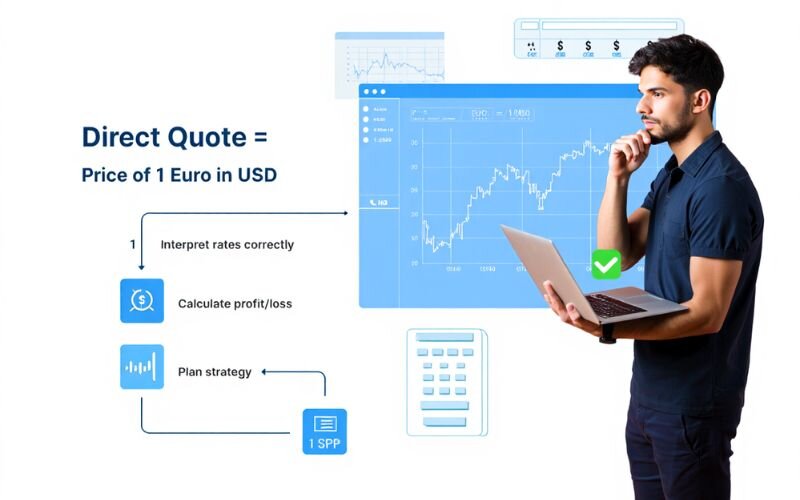
For traders in the United States, it's particularly useful to note that many of the major currency pairs are typically presented as direct quotations. Pairs such as EUR/USD, GBP/USD, AUD/USD, and NZD/USD all feature the U.S. Dollar as the quote currency. This means the rate directly tells you how many U.S. Dollars are needed to buy one unit of the base (foreign) currency.
In discussions about currency quotations, you might also encounter the terms "American terms" and "European terms":
- American terms: This generally refers to a quotation where the U.S. Dollar is the quote currency, and the rate expresses the value of one unit of a foreign currency in U.S. Dollars (e.g., 1 EUR = 1.0850 USD). For a U.S. resident, this is essentially a direct quotation.
- European terms: Conversely, this typically describes a quotation where the U.S. Dollar is the base currency, and the rate expresses the value of one U.S. Dollar in units of a foreign currency (e.g., 1 USD = 1.3500 CAD). For a U.S. resident, this is an indirect quotation.
It's important to remember that these terms are conventions, and the core understanding of direct versus indirect quotes, based on your domestic currency, remains the most practical approach.
6. Is USD/EUR a direct quote? Understanding the perspective is key
A common point of confusion for newcomers revolves around specific currency pairs like USD/EUR. So, is USD/EUR a direct quote? The answer is: it depends entirely on your perspective, specifically, what you consider your domestic currency. The concept of a quotation being direct or indirect is relative to the observer's home currency.
-
For an individual in the United States (where USD is the domestic currency):
The pair EUR/USD (e.g., EUR/USD = 1.0850) is a direct quotation. It directly tells them that 1 Euro costs 1.0850 U.S. Dollars.
If the pair were quoted as USD/EUR (which would mathematically be the inverse, approximately 1 / 1.0850 = 0.9216), meaning 1 USD = 0.9216 EUR, this would be an indirect quotation for the U.S. resident. It shows how much foreign currency (EUR) one unit of their domestic currency (USD) can buy.
-
For an individual in the Eurozone (where EUR is the domestic currency):
The pair USD/EUR (e.g., USD/EUR = 0.9216) would be a direct quotation. It directly tells them that 1 U.S. Dollar costs 0.9216 Euros.
Conversely, the pair EUR/USD (e.g., EUR/USD = 1.0850) would be an indirect quotation for the Eurozone resident. It shows how much foreign currency (USD) one unit of their domestic currency (EUR) can buy.
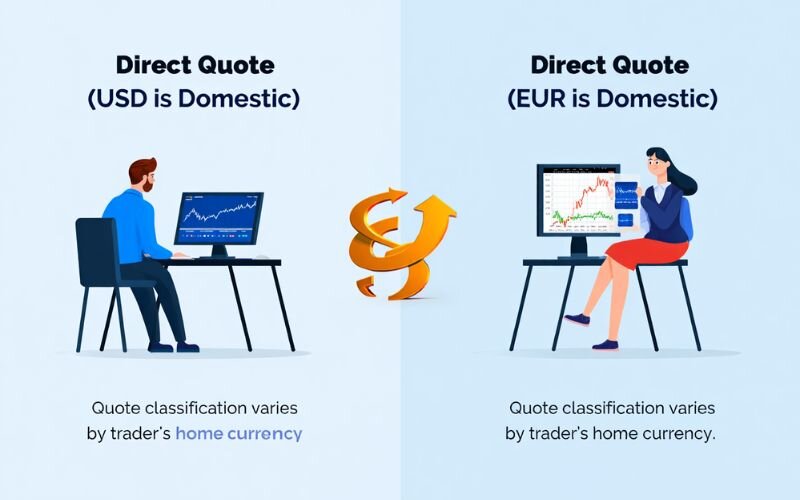
It's crucial to remember that this article, and the examples used, primarily adopt the perspective of a trader or individual in the United States, where the U.S. Dollar is the domestic currency. Therefore, when we discuss what is direct quotation, we generally refer to pairs where the USD is the quote currency (e.g., EUR/USD, GBP/USD).
7. FAQ about direct quotation
Q1. What is an example of a direct quote in Forex?
A: For a trader in the United States (where USD is the domestic currency), an excellent direct quotation example is EUR/USD = 1.0850. This means that 1 Euro (the foreign currency, acting as the base currency) is valued at 1.0850 U.S. Dollars (the domestic currency, acting as the quote currency). Similarly, GBP/USD = 1.2700 is another common direct currency quotation.
Q2. What is the difference between a quotation and a direct quotation in Forex?
A: In Forex, a "quotation" is simply the price of one currency expressed in terms of another currency. A "direct quotation" is a specific method of presenting that quotation. It's where the value of one unit of a foreign currency is expressed in terms of the viewer's domestic currency. So, a direct quotation is a type of quotation.
Q3. What is the difference between direct and indirect quotation in Forex?
A: The main difference between direct and indirect quotation lies in which currency (domestic or foreign) is treated as the base currency (valued at one unit).
- Direct quotation: The foreign currency is the base currency, and the domestic currency is the quote currency (e.g., for a U.S. trader: EUR/USD – how many USD for 1 EUR).
- Indirect quotation: The domestic currency is the base currency, and the foreign currency is the quote currency (e.g., for a U.S. trader: USD/JPY – how many JPY for 1 USD).
Understanding direct vs indirect quotation helps you read rates accurately.
Q4. How is a direct quotation expressed?
A: A direct quotation is expressed as a currency pair, for instance, EUR/USD = 1.0850. Here, the first currency (EUR) is the base currency (typically the foreign currency in a direct quote) and always represents one unit. The second currency (USD) is the quote currency (typically the domestic currency in a direct quote), and the number (1.0850) indicates how many units of the quote currency are needed to buy one unit of the base currency.
Q5. How does direct quotation relate to base and quote currency?
A: In a direct quotation, the foreign currency takes on the role of the base currency, and the viewer's domestic currency acts as the quote currency. The exchange rate itself shows how many units of the quote currency are required to exchange for one unit of the base currency.
Q6. Is USD/EUR a direct quote?
A: This depends on your location or your designated domestic currency. For someone in the United States (where USD is domestic), USD/EUR (e.g., 1 USD = 0.92 EUR) is an indirect quotation because it shows how much of a foreign currency (EUR) one unit of their domestic currency (USD) can buy. Conversely, EUR/USD would be the direct quotation for them.
Q7. Is Eurusd a direct or indirect quote?
EUR/USD is considered a direct quote because it expresses the value of one Euro (EUR) in terms of US Dollars (USD). In this currency pair, the Euro is the base currency and the US Dollar is the quote currency. This means that the price indicates how many US Dollars are needed to purchase one Euro.
8. Conclusion
Clearly understanding what is a direct quotation is one of the solid foundation stones that will help you navigate the Forex market with greater confidence as you begin your trading journey. Grasping how to read a direct quote, distinguish it from an indirect quote, and understand the roles of the base and quote currency will be immensely supportive.
How are Forex rates determined? Read our guide on the Forex Basics section for more essential trading knowledge. Continue your learning journey with H2T Finance!
